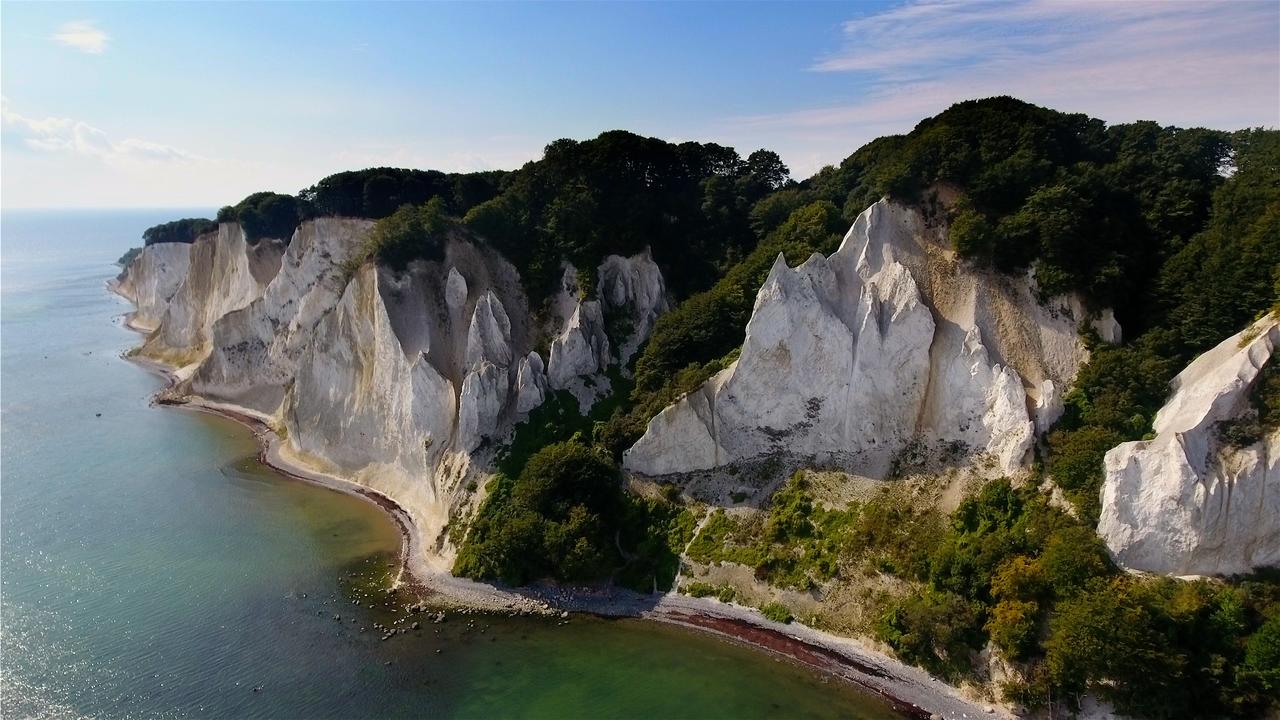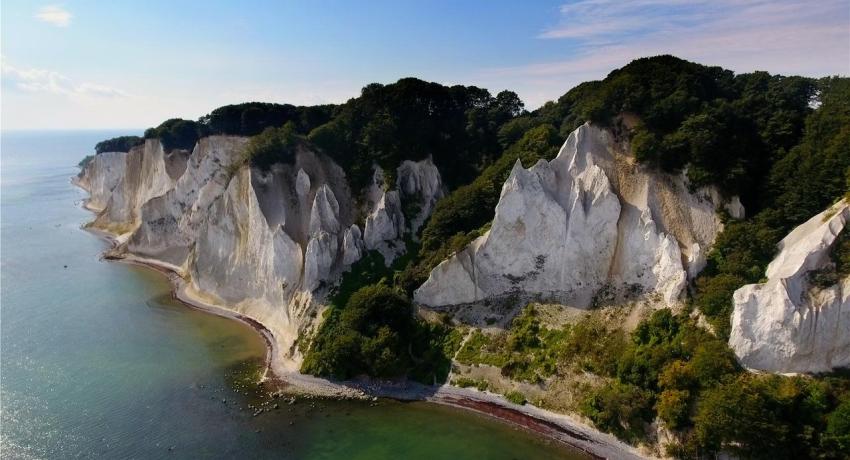Visit the Møns Klint cliffs
These white chalk cliffs are one of the most iconic landmarks of Møn. You can go for a walk along the cliffs and enjoy the stunning views of the Baltic Sea.
Møns Klint is a breathtakingly beautiful stretch of chalk cliffs located on the island of Møn in Denmark. The cliffs rise 128 meters (420 feet) above the Baltic Sea and are a popular tourist destination.
The cliffs were formed during the last Ice Age, about 15,000 years ago, when glaciers pushed large amounts of sediment into the Baltic Sea. Over time, the sediment was compressed into chalk and limestone, which were then exposed as the sea level fell and the land rose.
Møns Klint is known for its striking white cliffs, which are streaked with black lines of flint. The contrast between the white chalk and the dark flint creates a dramatic and beautiful landscape. Visitors can hike along the cliff top trail, which offers stunning views of the sea and the surrounding countryside. The area is also home to a variety of wildlife, including rare birds and plants.
In addition to its natural beauty, Møns Klint is also known for its cultural history. The area has been inhabited since the Stone Age, and there are several ancient burial mounds and other archaeological sites in the area. In the 19th century, the cliffs became a popular destination for artists and writers, who were inspired by the dramatic landscape.
Overall, Møns Klint is a must-see destination for anyone visiting Denmark. Its natural beauty and rich history make it a truly unique and unforgettable place.
Enjoy the Dark Sky Park
Dark Sky Møn is an initiative aimed at preserving the natural darkness of the night sky on the island of Møn in Denmark. The initiative was launched in 2017 by a group of local residents and astronomers who were concerned about the impact of light pollution on the island's natural beauty and the visibility of the stars.
Dark Sky Møn works to reduce light pollution on the island by encouraging local residents to use outdoor lighting that is designed to minimize light spill and glare. The initiative also works to raise awareness about the importance of preserving natural darkness, and offers educational programs and events to help people learn about the night sky and the impact of light pollution.
As a result of these efforts, Møn has become a popular destination for stargazers and astrophotographers, who come to the island to experience its dark skies and see the stars in all their glory. In fact, Møn was designated as Denmark's first International Dark Sky Park in 2019, in recognition of its efforts to preserve natural darkness and promote stargazing.
Overall, Dark Sky Møn is an important initiative that highlights the importance of preserving the natural beauty of the night sky, and provides a unique and unforgettable experience for visitors to the island.
Explore the Møn Museum
This museum provides an insight into the local history and culture of the island. You can see a collection of historical artifacts and learn about the region's Viking past.
Visit the Liselund Castle
This romantic castle is surrounded by a beautiful park with stunning landscapes, lakes, and a Chinese pavilion.
Liselund Castle is a historic manor house located on the island of Møn in Denmark, near the town of Stege. The castle was built in the late 18th century by the Danish nobleman Antoine de la Calmette and his wife, Elisabeth von Brüggemann.
The castle was designed in the romantic style, with a thatched roof, half-timbered walls, and Gothic details. The surrounding gardens were also designed to be picturesque, with winding paths, small lakes, and a variety of plants and flowers.
Liselund Castle has a rich history, and has been owned by several different families over the years. In the mid-19th century, it was owned by the Danish author Bernhard Severin Ingemann, who wrote many of his most famous works there.
Today, Liselund Castle is a popular tourist attraction, and visitors can tour the castle and gardens. The castle is also used for cultural events, such as concerts and exhibitions.
Overall, Liselund Castle is a beautiful and historic destination on the island of Møn, and is well worth a visit for anyone interested in Danish history and culture.
Go hiking or cycling
Møn offers many beautiful hiking and cycling trails that allow you to explore the island's stunning landscapes and nature reserves.
Møn is a popular destination for hikers, with a variety of trails that offer stunning views of the island's natural beauty. Here are a few of the most popular hiking trails on Møn:
-
Møns Klint: The cliff top trail at Møns Klint is one of the most popular hikes on the island. The trail follows the edge of the cliffs, offering spectacular views of the sea and the surrounding countryside. The trail is about 6 kilometers long and takes about 2-3 hours to complete.
-
Geocenter Møns Klint: The Geocenter at Møns Klint offers several hiking trails that explore the geological history of the area. The trails range from easy walks to more challenging hikes, and offer a unique opportunity to learn about the formation of the chalk cliffs.
-
Nyord Island: Nyord is a small island off the coast of Møn that is known for its natural beauty and peaceful atmosphere. The island has several hiking trails that wind through its picturesque landscapes, including beaches, meadows, and marshes.
-
Ulvshale Forest: Ulvshale Forest is a large nature reserve on the southern end of Møn. The forest has several hiking trails that explore its diverse landscapes, including forests, meadows, and wetlands. The trails range from easy walks to more challenging hikes.
Overall, Møn is a great destination for hikers of all skill levels, with trails that offer stunning views of the island's natural beauty and unique geological history.
Visit the Fanefjord Church
Fanefjord church is known for its beautiful frescoes and is considered one of Denmark's most significant medieval churches.
anefjord Church is a historic church located on the island of Møn in Denmark, near the town of Vordingborg. The church dates back to the 12th century and is known for its well-preserved frescoes.
The frescoes in Fanefjord Church are considered some of the finest examples of Romanesque wall paintings in Denmark. They were painted in the 13th century and depict scenes from the Bible, including the life of Christ, the Last Judgment, and the Garden of Eden.
In addition to the frescoes, Fanefjord Church is also known for its unique architecture. The church has a circular nave and a square chancel, which is a rare design in Denmark. The church also has a bell tower that was added in the 16th century.
Today, Fanefjord Church is a popular tourist attraction, and visitors can tour the church and see the frescoes up close. The church is also used for concerts and other cultural events.
Overall, Fanefjord Church is a beautiful and historic destination on the island of Møn, and is well worth a visit for anyone interested in Danish history and culture.
Explore the Geocenter Møns Klint
This interactive museum provides an insight into the geological history of the region and offers various activities for visitors of all ages.
Go for a swim
Møn is known for its beautiful beaches, which offer a variety of landscapes and activities. Here are some of the most popular beaches on Møn:
-
Rytzebæk Beach: Rytzebæk Beach is located on the eastern coast of Møn and is known for its wide sandy beach and clear water. The beach is popular for swimming, sunbathing, and fishing.
-
Klintholm Havn Beach: Klintholm Havn Beach is located on the southern coast of Møn and is known for its shallow water and gentle waves. The beach is popular for swimming, windsurfing, and kitesurfing.
-
Ulvshale Beach: Ulvshale Beach is located on the southeastern coast of Møn and is known for its long sandy beach and dunes. The beach is popular for swimming, sunbathing, and hiking.
-
Hjelm Beach: Hjelm Beach is located on the northern coast of Møn and is known for its rocky landscape and clear water. The beach is popular for fishing and diving.
-
Stege Bay Beach: Stege Bay Beach is located on the western coast of Møn and is known for its shallow water and mudflats. The beach is popular for birdwatching, kayaking and hiking.
Overall, Møn has a variety of beaches to suit all interests, from wide sandy beaches to rocky coastlines. The beaches are also surrounded by beautiful natural landscapes, making them a popular destination for outdoor enthusiasts.
Chalk Paintings and Frescoes in the Churches
Møn is known for its beautiful and unique kalkmalerier or chalk paintings. These paintings are found on the ceilings of many churches in the region and date back to the Middle Ages. The paintings were made using a technique where the artist would paint directly onto the wet plaster, which would then dry and harden, preserving the artwork for centuries.
One of the most well-known churches on Møn with kalkmalerier is the Fanefjord Church. This church has some of the most extensive and well-preserved kalkmalerier in Denmark. The paintings depict scenes from the Bible, including the story of Noah's Ark, the Last Supper, and the Crucifixion.
Other churches on Møn with kalkmalerier include the Elmelunde Church, which has some of the oldest paintings dating back to the 12th century, and the Keldby Church, which has colorful and detailed paintings of saints and angels.
While Møn is primarily known for its Chalk Paintings, there are also some frescoes to be found in the churches on the island. Frescoes are paintings made on fresh, wet plaster, which allows the pigments to penetrate the plaster and become part of the wall surface. The result is a durable and long-lasting artwork that is integrated into the architecture of the building.
One of the most significant churches on Møn with frescoes is the Nyord Church, which has some of the best-preserved frescoes in Denmark. The frescoes date back to the 14th century and depict scenes from the life of Christ, including the Nativity, the Crucifixion, and the Resurrection. There are also images of saints and angels, as well as inscriptions in Latin and Gothic script.
Another church on Møn with frescoes is the Magleby Church, which has a cycle of frescoes depicting the Seven Deadly Sins. The frescoes are thought to have been painted in the 15th century and are a rare example of this subject matter in Danish church art.
Visitors to Møn can take guided tours of these churches to learn more about the history and significance of the kalkmalerier. The churches are also open for worship services and visitors are welcome to attend, but it is important to be respectful of the sacred space and the artwork.
These are just some of the many things you can do on a holiday on Møn, Denmark. The island has much more to offer, so you can always do some more research and plan your activities according to your interests.


